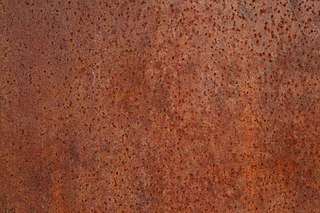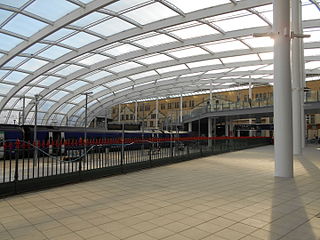Related Research Articles

Rebar, known when massed as reinforcing steel or steel reinforcement, is a steel bar used as a tension device in reinforced concrete and reinforced masonry structures to strengthen and aid the concrete under tension. Concrete is strong under compression, but has low tensile strength. Rebar significantly increases the tensile strength of the structure. Rebar's surface features a continuous series of ribs, lugs or indentations to promote a better bond with the concrete and reduce the risk of slippage.

An I-beam is any of various structural members with an I or H-shaped cross-section. Technical terms for similar items include H-beam, universal column (UC), w-beam, universal beam (UB), rolled steel joist (RSJ), or double-T. I-beams are typically made of structural steel and serve a wide variety of construction uses.

Weathering steel, often referred to by the genericised trademark COR-TEN steel and sometimes written without the hyphen as corten steel, is a group of steel alloys which were developed to eliminate the need for painting, and form a stable rust-like appearance after several years' exposure to weather.

Structural steel is a category of steel used for making construction materials in a variety of shapes. Many structural steel shapes take the form of an elongated beam having a profile of a specific cross section. Structural steel shapes, sizes, chemical composition, mechanical properties such as strengths, storage practices, etc., are regulated by standards in most industrialized countries.
A514 is a particular type of high strength steel, which is quenched and tempered alloy steel, with a yield strength of 100,000 psi. The ArcelorMittal trademarked name is T-1. A514 is primarily used as a structural steel for building construction. A517 is a closely related alloy that is used for the production of high-strength pressure vessels.
ABS Steels are types of structural steel which are standardized by the American Bureau of Shipping for use in shipbuilding.
6061 aluminium alloy is a precipitation-hardened aluminium alloy, containing magnesium and silicon as its major alloying elements. Originally called "Alloy 61S", it was developed in 1935. It has good mechanical properties, exhibits good weldability, and is very commonly extruded. It is one of the most common alloys of aluminium for general-purpose use.
2024 aluminium alloy is an aluminium alloy, with copper as the primary alloying element. It is used in applications requiring high strength-to-weight ratio, as well as good fatigue resistance. It is weldable only through friction welding, and has average machinability. Due to poor corrosion resistance, it is often clad with aluminium or Al-1Zn for protection, although this may reduce the fatigue strength. In older systems of terminology, 2XXX series alloys were known as duralumin, and this alloy was named 24ST.
5086 aluminium alloy is an aluminium–magnesium alloy, primarily alloyed with magnesium. It is not strengthened by heat treatment, instead becoming stronger due to strain hardening, or cold mechanical working of the material.

Cold-formed steel (CFS) is the common term for steel products shaped by cold-working processes carried out near room temperature, such as rolling, pressing, stamping, bending, etc. Stock bars and sheets of cold-rolled steel (CRS) are commonly used in all areas of manufacturing. The terms are opposed to hot-formed steel and hot-rolled steel.
ASTM A992 steel is a structural steel alloy often used in the US for steel wide-flange and I beams. Like other carbon steels, the density of ASTM A992 steel is approximately 7850 kg/m3. ASTM A992 steel has the following minimum mechanical properties, according to ASTM specification A992/A992M. Tensile yield strength, 345 MPa (50 ksi); tensile ultimate strength, 450 MPa (65 ksi); strain to rupture in a 200-mm-long test specimen, 18%; strain to rupture in a 50-mm-long test specimen, 21%.
ASTM A325 is an ASTM International standard for heavy hex structural bolts, titled Standard Specification for Structural Bolts, Steel, Heat Treated, 120/105 ksi Minimum Tensile Strength. It defines mechanical properties for bolts that range from 1⁄2 to 1+1⁄2 inches in diameter.

The pound per square inch or, more accurately, pound-force per square inch, is a unit of measurement of pressure or of stress based on avoirdupois units. It is the pressure resulting from a force with magnitude of one pound-force applied to an area of one square inch. In SI units, 1 psi is approximately 6,895 pascals.
Concrete has relatively high compressive strength, but significantly lower tensile strength. The compressive strength is typically controlled with the ratio of water to cement when forming the concrete, and tensile strength is increased by additives, typically steel, to create reinforced concrete. In other words we can say concrete is made up of sand, ballast, cement and water.
5154 aluminium alloy is an alloy in the wrought aluminium-magnesium family. As an aluminium-magnesium alloy, it combines moderate-to-high strength with excellent weldability. 5154 aluminium is commonly used in welded structures such as pressure vessels and ships. As a wrought alloy, it can be formed by rolling, extrusion, and forging, but not casting. It can be cold worked to produce tempers with a higher strength but a lower ductility. It is generally not clad.
5454 aluminium–magnesium alloy is an alloy in the wrought aluminium-magnesium family. It is closely related to 5154 aluminium alloy. As an aluminium-magnesium alloy, it combines moderate-to-high strength with excellent weldability. Like 5154, 5454 aluminium is commonly used in welded structures such as pressure vessels and ships. As a wrought alloy, it can be formed by rolling, extrusion, and forging, but not casting. It can be cold worked to produce tempers with a higher strength but a lower ductility. It is generally not clad.
5456 aluminium–magnesium alloy is an alloy in the wrought aluminium-magnesium family. While it is closely related to 5356 aluminium alloy, it is used in structural applications, like most other aluminium-magnesium alloys, and not as filler for welding. As a wrought alloy, it can be formed by rolling, extrusion, and forging, but not casting. It can be cold worked to produce tempers with a higher strength but a lower ductility. It is susceptible to exfoliation corrosion when held at temperatures above 65 °C (150 °F) for extended periods of time.
6060 aluminium alloy is an alloy in the wrought aluminium-magnesium-silicon family. It is much more closely related to the alloy 6063 than to 6061. The main difference between 6060 and 6063 is that 6063 has a slightly higher magnesium content. It can be formed by extrusion, forging or rolling, but as a wrought alloy it is not used in casting. It cannot be work hardened, but is commonly heat treated to produce tempers with a higher strength but lower ductility.
6105 aluminium alloy is an alloy in the wrought aluminium-magnesium-silicon family. It is one of the least common of the alloys in this series. While most wrought aluminium alloys are covered by multiple standards, 6105 is only dealt with in ASTM B221: Standard Specification for Aluminum and Aluminum-Alloy Extruded Bars, Rods, Wire, Profiles, and Tubes. It is formed by extrusion, and supplied in heat treated form. It can alternately referred to by the UNS designation A96105.

The López Serrano Building was the tallest residential building in Cuba until the construction of the FOCSA in 1956. Designed by the architect Ricardo Mira in 1929, who in 1941 who also designed La Moderna Poesia bookstore on Obispo Street for the same owner, it is often compared to the Bacardi Building in Old Havana built two years before the López Serrano Building because of their similarity in massing and central tower. The congressman, senator, and presidential candidate Eduardo Chibás was living on the fourteenth-floor penthouse when he committed suicide in August 1951 on the air at CMQ Radio Station.
References
- 1 2 Steel Construction Manual, 8th Edition, second revised edition, American Institute of Steel Construction, 1986, Ch. 1 pp. 1–5.
- ↑ Kurt Gustafson ,Evaluation of Existing Structures, Steelwise, American Institute of Steel Construction, February 2007.
- ↑ ASTM A7 (dead link 27 April 2023)
- ↑ ASTM A9 dead link 27 April 2023)
- ↑ Historical Listing of Selected Structural Steels, Canadian Institute of Steel Construction, retrieved Oct. 2021.
- ↑ "MatWeb A36 steel bar". MatWeb. Retrieved 21 January 2012.